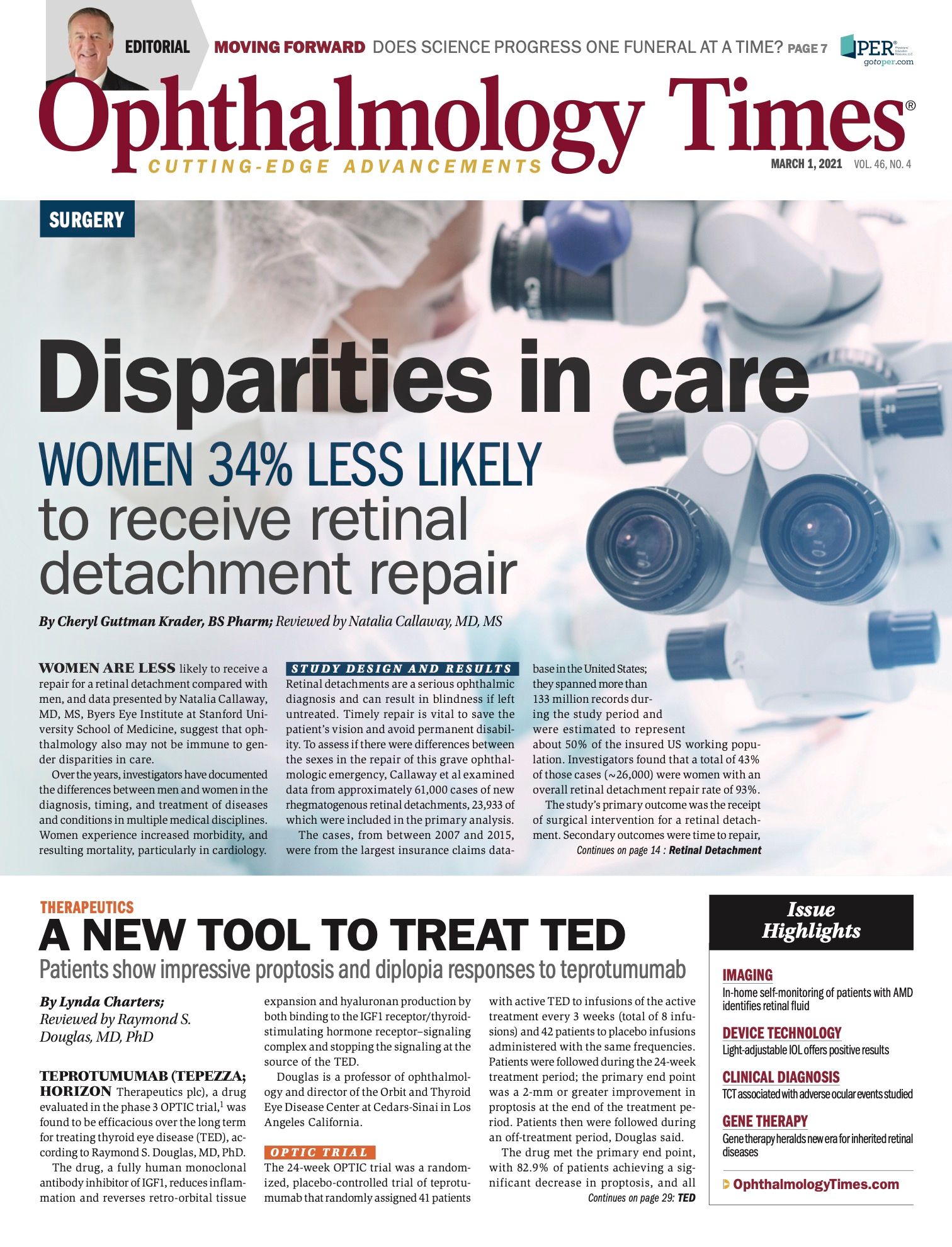Publication
Article
Digital Edition
Surgery for external ocular diseases: Managing common presentations
Author(s):
Ophthalmologist offers pearls for management, treatment of myriad issues.

This article was reviewed by Zaina Al-Mohtaseb, MD
A number of ocular issues present frequently and are linked with a substantial amount of patient discomfort. In some cases, surgical intervention can avoid complications and reduce patient morbidity.
Woodford Van Meter, MD, FACS, offered his pearls to manage patient comfort and vision, as well as provide tectonic support for the ocular surface. He is a professor of ophthalmology at the University of Kentucky in Lexington.
Persistent epithelial defects
These lesions are defined as persistent if present for more than 3 days. Van Meter underscored the importance of identifying the underlying etiology, such as dry eye, neurotrophic keratitis, and rheumatoid arthritis or other systemic autoimmune disorders.
Related: Are posterior corneal curvature changes culprit in hyperopic shifts?
Initial treatments, which are designed to restore and then protect the corneal surface, include artificial tears followed by a patch or bandage contact lens to heal the defect.
When patients are symptomatic, Van Meter advises using punctal occlusion with temporary plugs or, for a chronic defect, permanent plugs with cautery. Other treatment options include serum tears and scleral contact lenses.
Lateral tarsorrhaphy is the last resort, he pointed out; a temporary lateral tarsorrhaphy such as a Frost suture can be used for 1 or 2 weeks if the defect is small or recent.
In cases in which the lids will be closed for a longer period, a permanent, although reversible, tarsorrhaphy can be done.
Related: Harnessing 1-2 punch of KAMPs for corneal infection, inflammation
Recurrent corneal erosions
Patients usually present with pain on awakening in association with epithelial sloughs from the cornea. “These are some of the most difficult to care for in a corneal practice,” Van Meter said.
There is no pattern to the appearance of the pain. Patients may report that they are pain free for varying intervals between corneal erosions.
Examinations identify abrasions with surrounding edematous epithelium that are often sliding around on the cornea; the loose epithelium slows wound healing.
Two types of corneal erosions exist: anterior membrane dystrophy, in which the epithelial breakdown develops from redundant epithelial basement membrane of unknown etiology, and an erosion following trauma, in which the breakdown stems from the absence of hemidesmosomes resulting from loss of the epithelial basement, which can occur after an injury caused by a fingernail or paper.
Related: Teaching AI algorithms to identify corneal pathology: The future is now
Anterior membrane dystrophy
Treatment of anterior membrane dystrophy involves superficial keratectomy to remove the redundant epithelial basement membrane by scraping with a surgical blade.
For posttraumatic corneal erosion, treatment entails corneal needle puncture to induce adhesions of the epithelium to the underlying stroma by which type IV collagen that facilitates adherence of the epithelial cells to the stroma.
Phototherapeutic keratectomy is a procedure that is often performed in patients with recurrent erosions.
Van Meter also described another frequently overlooked cause of corneal erosion—nocturnal lagophthalmos.
This type of erosion is also characterized by pain that starts in middle of the night or in the morning upon awakening. The onset is variable and may go for days.
Related: DMEK in 'super' seniors: feasible treatment, realistic expectations
A clue to a patient’s diagnosis: The disruption of the epithelium occurs where the lids meet, he said, near the junction of the lower and middle third of the cornea.
A helpful insight involves the recognition of REM sleep’s contribution to the erosion. Van Meter noted that REM sleep occurs right before awakening; the origins of the levator and superior rectus muscles are adjacent, and frequently the muscle fibers are intertwined.
“Ordinarily, upon looking superiorly, the lid goes up,” he said. “At night, when the lid goes up from the levator muscle, it is frequently associated with the superior rectus muscle elevating the globe during REM sleep.”
Treatment includes lubrication and using patching at night or a sleep mask to keep the lids closed and protect the epithelium.
In many cases, family members report that the patient sleeps with their eyes open—another clue to diagnosis. Tarsorrhaphy is a last resort.
Related: CXL imperative in treatment of pediatric keratoconus
However, this is a mechanical problem, and there is no issue with the corneal epithelium or basement membrane.
Superior limbal keratoconjunctivitis
This painful pathology results from keratinization of the superior conjunctiva above the 12:00 limbus, which causes a foreign body sensation and is associated with thyroid disease.
The initial treatment is punctal occlusion to improve the tear film. If unsuccessful, conjunctival cautery or resection of the keratinized superior conjunctiva can be performed.
This procedure includes injecting 1% lidocaine with epinephrine just below the conjunctival surface above the 12:00 limbus to cause ballooning of the conjunctiva; this facilitates resecting of the thin conjunctival tissue.
Applying a 1% solution of rose bengal stain establishes the diagnosis by highlighting the keratinized tissue. It is noteworthy that staining with fluorescein results in false negatives.
Related: Hardware, software offer surgeons a window to cornea diagnosis
Peripheral ulcerative keratitis
This painful pathology, which includes a Mooren ulcer, requires immediate intervention. Van Meter noted that this form of keratitis is a peripheral melt with necrotic overhanging edges.
Generally, it is a type of crescent-shaped inflammatory damage that occurs in the limbal region of the cornea.
Van Meter emphasized that if the corneal melt is rheumatoid in nature, the patient should be evaluated by a rheumatologist to receive systemic treatment for what might well be out-of-control rheumatoid arthritis.
Related: Doing justice to corneal irregularities
Treatment can include conjunctival resection to push the conjunctiva away from the limbus to remove the source of inflammatory cells, amniotic membrane transplantation, and a permanent lateral tarsorrhaphy, which can be reversed with disease stabilization, he advised.
Conclusion
“Surgical intervention helps avoid complications of external eye diseases and reduce patient morbidity,” Van Meter concluded. “Early recognition of a disease process is important, as is understanding how common surgical procedures can mitigate complications of different eye diseases.”
--
Woodford Van Meter, MD, FACS
e:wsv@uky.edu
Van Meter has no financial interest in this subject matter.

Newsletter
Don’t miss out—get Ophthalmology Times updates on the latest clinical advancements and expert interviews, straight to your inbox.





